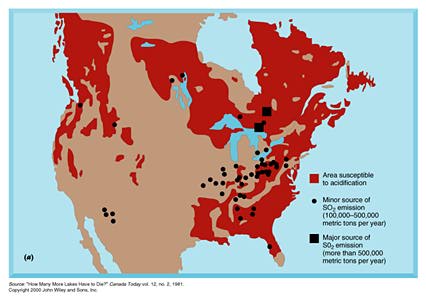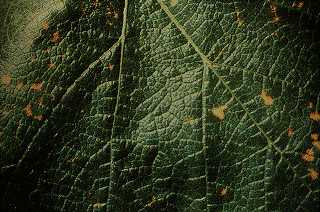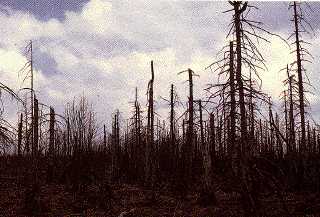 Leaf or foliage damage from standing in acidified clouds can be more harmful
than having acid rain soak the ground, since the ground will tend to neutralize
the acids while the acid cloud droplets damage the means for the plant to manufacture
its own food via photosynthesis (see photo below).
Leaf or foliage damage from standing in acidified clouds can be more harmful
than having acid rain soak the ground, since the ground will tend to neutralize
the acids while the acid cloud droplets damage the means for the plant to manufacture
its own food via photosynthesis (see photo below).
An interesting side effect is that forest decline provides a link between acid
deposition and global climate change. If large stands of forest are affected
by a widespread plume of acidic gases, this may significantly reduce the atmosphere
CO2 sink and lead to climate change.
 The regions shaded in red are areas of North America that are deemed susceptible
to acidification. The black dots and squares are locations of sulfur sources,
such as electric power plants. The very middle of the U.S., in Colorado, also
used to be a significant source, but Public Service (the provider of electric
power) recently converted their power generating plants to natural gas and clean
coal processes.
The regions shaded in red are areas of North America that are deemed susceptible
to acidification. The black dots and squares are locations of sulfur sources,
such as electric power plants. The very middle of the U.S., in Colorado, also
used to be a significant source, but Public Service (the provider of electric
power) recently converted their power generating plants to natural gas and clean
coal processes.
In the northeastern part of the U.S. are the Adirondack Mountains, the
location of high-altitude forests.
 Brown patches are from acid water droplets burning the leaf.
Brown patches are from acid water droplets burning the leaf.
 This is a dead, acid-damaged forest in the Czech republic. This region is
directly downwind of the coal-fired power plants in West Germany.
This is a dead, acid-damaged forest in the Czech republic. This region is
directly downwind of the coal-fired power plants in West Germany.



 Leaf or foliage damage from standing in acidified clouds can be more harmful
than having acid rain soak the ground, since the ground will tend to neutralize
the acids while the acid cloud droplets damage the means for the plant to manufacture
its own food via photosynthesis (see photo below).
Leaf or foliage damage from standing in acidified clouds can be more harmful
than having acid rain soak the ground, since the ground will tend to neutralize
the acids while the acid cloud droplets damage the means for the plant to manufacture
its own food via photosynthesis (see photo below). The regions shaded in red are areas of North America that are deemed susceptible
to acidification. The black dots and squares are locations of sulfur sources,
such as electric power plants. The very middle of the U.S., in Colorado, also
used to be a significant source, but Public Service (the provider of electric
power) recently converted their power generating plants to natural gas and
The regions shaded in red are areas of North America that are deemed susceptible
to acidification. The black dots and squares are locations of sulfur sources,
such as electric power plants. The very middle of the U.S., in Colorado, also
used to be a significant source, but Public Service (the provider of electric
power) recently converted their power generating plants to natural gas and  Brown patches are from acid water droplets burning the leaf.
Brown patches are from acid water droplets burning the leaf. This is a dead, acid-damaged forest in the Czech republic. This region is
directly downwind of the coal-fired power plants in West Germany.
This is a dead, acid-damaged forest in the Czech republic. This region is
directly downwind of the coal-fired power plants in West Germany.